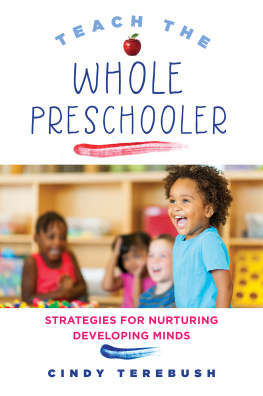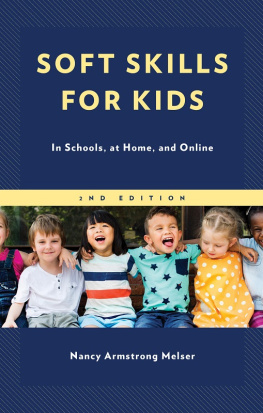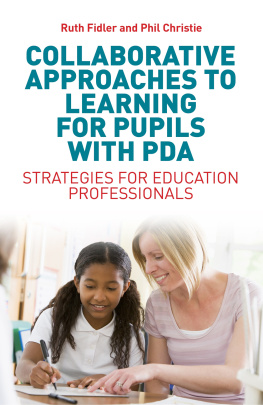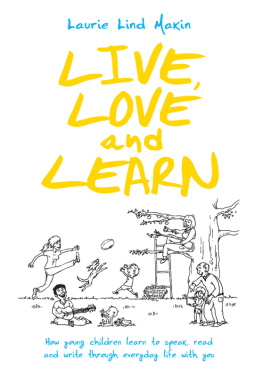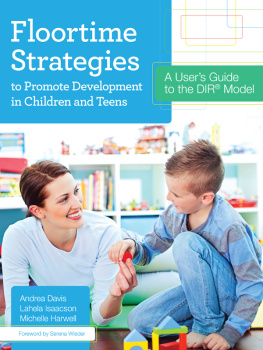
TEACH THE

WHOLE
PRESCHOOLER

Strategies for Nurturing
Developing Minds
CINDY TEREBUSH

W.W. Norton & Company
Independent Publishers Since 1923
New York London
NORTON BOOKS IN EDUCATION
TEACH THE
WHOLE
PRESCHOOLER
Teach The Whole Preschooler
Strategies for Nurturing Developing Minds
Cindy Terebush
Copyright 2017 by Cindy Terebush
Interior photos by Steven D. Katz
All rights reserved
FIRST EDITION
For information about permission to reproduce selections from this book,
write to Permissions,
W. W. Norton & Company, Inc.
500 Fifth Avenue
New York, NY 10110
For information about special discounts for bulk purchases,
please contact W. W. Norton
Special Sales at specialsales@wwnorton.com or 800-233-4830
Book design by Molly Heron
Production manager: Christine Critelli
COVER DESIGN BY LAUREN GRAESSLE
COVER PHOTO FATCAMERA
The Library of Congress has cataloged the printed edition as follows:
ISBN: 978-0-393-71154-7 (pbk.)
ISBN: 978-0-393-71155-4 (e-book)
W. W. Norton & Company, Inc.
500 Fifth Avenue
New York, N.Y. 10110
www.wwnorton.com
W. W. Norton & Company Ltd.,
15 Carlisle Street, London W1D 3BS
Note to Readers
Models and/or techniques described in this volume are illustrative
or are included for general informational purposes only;
neither the publisher nor the author(s) can guarantee the efficacy
or appropriateness of any particular recommendation
in every circumstance.
Dedicated to
Michael Terebush and Scott Terebush,
who make me proud to be called Mom
and
Todd Terebush,
for whom mere words cannot express
my gratitude and love.
Everyone should have a partner
as supportive as you.
I was sitting in a hotel lobby when I received an email from Deborah Malmud, a vice-president at W.W. Norton & Company, Inc. and the editorial director of the professional books division. She asked if Id ever considered putting my talks in a book format. I blog. I write articles for other venues, and yes, I had considered it, but I certainly didnt have a manuscript yet. After I spoke with Deborah, I began a process that I knew would be a pivotal time in my professional life. I had grown accustomed to standing in front of audiences, but now I had an opportunity to reach so many more people. I spent a lot of time thinking about the message that I want to share about what is good and right for young children and the impact of this unique opportunity. I knew it would be a daunting task and was slightly tempted to shy away from it, but when doors open I do believe in walking through them. What did I want to say in the 50,000 words or more that make a book, and how did I want to say it?
I have a pile of books next to my nightstand that are partially read. I started some but didnt feel compelled to keep reading them. Life distracted me and that was fine. I wasnt drawn in. Some were simply facts with no personality. Others were not relatable. I knew that I wanted to write a book that would be read from beginning to end. I thought about the feedback that I receive after speaking engagements. Many people comment that I am relatable, funny, and that they enjoy learning through stories that are part of the common experience of teaching in an early childhood setting. I have been told that both my presentations and my blog teach without criticizing. I knew that I wanted my book to be all of that. I want teachers to pick up this book and know that it is written by someone who understands themwho is one of them. All of us, children and adults, learn more when we find the task to be enjoyable. As you read this book, I hope you nod at the familiar and laugh with the irony of human behavior. I hope that you turn a page and think, Hmm. I hadnt thought about that situation that way before so I should think about that. More than anything, I hope you remember.
Remember childhood. Remember sitting on a swing with the warm summer sun on your skin as you developed gross motor skills and coordination by pumping your legs back and forth. Remember when your biggest responsibility was to put your toys away. Remember endless days playing with neighborhood children who also shared your journey to school and days in classrooms. Remember the teachers with whom you felt a connection and the kindness they offered you.
I ask adults to remember childhood and they tell tales of hours playing in their neighborhoods, going to playgrounds and exploring. Children need to play, explore, and discover how to survive in the world so they will be able to be independent of their parents. We know that their adults impact how they view the world and how they view themselves.
I say these things in front of audiences large and small, in filled classrooms, ballrooms, and lecture halls. Everyone nods. There is inevitably agreement, and yet the room is filled with people who want to hear that message. In the beginning of my speaking career, I wondered why the rooms filled if the educators already knew what I was saying to be true. I wondered why I filled rooms with people who seemed to already know what I was saying.
I started to pay a lot of attention to the evaluations that I received after conferences. Some conferences share the actual forms with presenters, and others send a summary. I know that filling out evaluation forms isnt a favorite activity at conferences, but for a presenter they are an important professional growth and learning tool. I read the comments so I can learn what audiences hear when they listen to me. I want to know if teachers learn something that they can take right to their classrooms or if they do not. By reading those comments, I have learned that teachers have not forgotten how young children learn. They simply feel stuck in a system that is speeding out of control on a road of unrealistic expectations and they dont know how to stop it.
This book will not teach you how to stop the runaway expectations. We cannot control that. We cannot stop parents from being afraid and worrying about their childrens success in todays world. We cannot stop governments from enacting educational policies that are contradictory to what is good for children. Over time, I hope that they understand from you and from people like me that they are on the wrong path, but we cannot put a screeching halt to it.
This book is about appropriate expectations of young children and so it has to model appropriate expectations of adults. It is not an immediate solution being published to end what we cannot end. It was written to teach and affirm appropriate expectations and to give educators ideas how to do what is right with the children in their care. This book is to help you to teach by controlling what you canyourself and your classroom environment.
It is not possible to turn back the clock to a time that we remember fondly. If that were possible, every generation would have gone back. My parents were nostalgic about the 1950s, and their parents lamented the end of the 1920s. They couldnt go back and neither can we. We can, however, learn effective ways to forge forward.
Effective educators spend their time trying to connect their students to new concepts through meaningful and impactful interactions. We care about process, brain development, and thinking skills. In every generation, the teachers biggest challenge is to take the information to the students rather than expect the students to come to us anxiously ready to receive all that we know. The adults have to go to the children. We have to go to the world in which they reside. Children now and forevermore reside in an instant information, highly paced, always connected world that revolves around consistently fed fears. It is so different than it was merely one generation ago.
Next page
